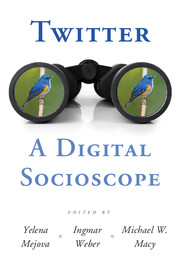Preface
Published online by Cambridge University Press: 05 May 2015
Summary
More than 500 million tweets are shared on Twitter each day, each devoting 140 characters to anything from announcements of dinner plans to calls for revolutions. Given its sheer size and the fact that most of its content is public, it is not surprising that Twitter has been extensively used to study human behavior on a global scale.
This book uses thematically grouped case studies to show how Twitter data can be used to analyze phenomena ranging from the number of people infected by the flu, to national elections, to tomorrow's stock prices. The idea for the book grew out of a three-hour tutorial on “Twitter and the Real World” given in October 2013 at the Conference on Information and Knowledge Management. Expanding on the topics covered in that tutorial, the book provides a wider thematic scope of research and the most recent scientific work.
All chapters are written by leading domain experts and take the reader to the forefront of the emerging new field of computational social science, using topical applications to illustrate the possibilities, advantages, and limitations of large, semi structured social media data to gain insights into human behavior and social interaction. Although most of the authors are computer scientists, the book is intended for readers who have not been exposed to formal training on how to analyze “big data.” To this end, unnecessary implementation details are avoided. Chapter 1, “Analyzing Twitter Data,” introduces readers to the tools and skills used in these studies and gives pointers on how to take the first steps as a novice researcher.
The opening chapter lays the groundwork for the book by surveying the opportunities and challenges of a “Twitter socioscope.” The chapters that follow are written to be stand-alone case studies that can be reordered according to the reader's needs and preferences.
Twitter will undoubtedly evolve and its usage will change, but even if it comes to be replaced by “the next big thing,” the detailed time-stamped records of hundreds of millions of global users will continue to be one of the most valuable sources of data on human behavior ever assembled, and these case studies will remain useful as an introduction to the methods, research opportunities, and challenges that these data present.
- Type
- Chapter
- Information
- Twitter: A Digital Socioscope , pp. ix - xPublisher: Cambridge University PressPrint publication year: 2015



